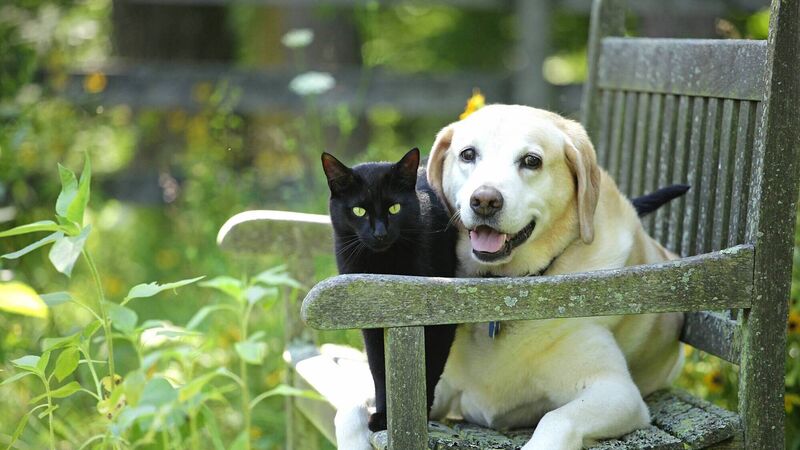Pete the Vet: How to keep your pets safe in Irish gardens

Pete the Vet: Keeping pets happy in the garden.
Spring is here and summer’s just around the corner. Temperatures have been rising, and the days are brighter and longer. Across Ireland, plants are growing, birdsong fills the air, and people are choosing to spend more time in their gardens.
Pets enjoy gardens just as much as we do, but they can be vulnerable to a number of risks that owners may not be aware of. This week, my aim is to highlight the common issues that can affect pets, to help owners keep their animals safe this summer.
Animals are prone to eating anything within reach that they find appealing, and that can include poisonous plants. It’s worth doing a plant scan of your garden (easier than ever, with the advent of smartphone plant identification apps) to make sure that you are aware of any potentially risky vegetation.
Common plants that are toxic to pets include chrysanthemums, daffodil bulbs, Larkspur, foxgloves, hydrangea, acorns, tomato plants, wisteria and yew. Their mere presence is not necessarily a huge issue: many animals co-exist with these plants safely. However it’s important to know your own garden and your own pet.
Some dogs are prone to chewing anything within reach, and if your dog starts to chew these plants, there’s likely to be a problem. You don’t need to dig up every individual plant but you do need to make sure that your dog doesn’t chew them. Careful monitoring is the best approach.
Cats are fussier than dogs, and less likely to dig up and eat plants, but there are some specific examples (such as lilies) that are highly toxic. Cats can be poisoned without eating the plant itself: typically, a cat might be dusted with lily pollen after brushing against the plant, and they swallow this toxic pollen when grooming themselves later, developing serious kidney failure as a result. It’s safest to keep lilies completely out of the range of cats to avoid this.
If your pet does eat a toxic plant, contact your vet at once. The easiest answer to poison ingestion is for the vet to give an injection which induces immediate regurgitation, removing the substance from the stomach before there has been time for it to be absorbed. However this must be done rapidly: ideally, less than an hour after the poison has been taken. If over an hour has passed, then do still talk to your vet, but it may be a case of monitoring the animal, looking out for any signs of poisoning, and treating them accordingly. This can include vomiting, diarrhoea and skin or mouth irritations, depending on the plant and how much has been eaten.
Some people take a strong preventive approach, removing all potentially poisonous plants, and replacing them with plants that are known for being “animal friendly”: these include plants like lavender, rosemary, calendula, dill and fennel. These are colourful, fragrant plants: you can have a beautiful garden which is completely safe for all animals.
Most gardeners use potentially toxic chemicals as part of their routine, and it’s always worth reading the label to check for any risk to pets.
Most weedkillers and fertilisers are hazardous when freshly applied, but safe when they have dried, so pets should be kept in until you are sure it’s safe. I’ve seen cats with severe burns to the tongue (requiring surgical installation of a feeding tube, to bypass the mouth until the burns healed) after the cat walked on wet weedkiller, then licked their feet afterwards.
Poisons like slug bait are palatable to dogs and cats, so they'll often eat it if they get a chance. If left out in areas accessible to pets, the consequences can be very serious. Affected dogs and cats show neurological signs, such as seizures and collapse, and without treatment, poisoning can be fatal. All such poisons should be kept out of the reach of pets at all times: there are plenty of pet friendly methods of pest control available.
Slugs and snails themselves are also dangerous to dogs: they carry lungworm larvae which can infest the dog if eaten. Lungworm causes a cough, but the parasite also stops the blood from clotting, and affected dogs can suffer fatal internal haemorrhage. I’ve seen two cases of young adult dogs that have died unexpectedly overnight: on autopsy, they were found to have suffered brain haemorrhages linked to lungworm infection. You can’t completely banish slugs and snails from your garden completely, so a once-monthly tablet or spot-on treatment from your vet is the best way to ensure that your pet is protected from this risk.
From lawnmowers to strimmers to hedge cutters, hazardous machinery is often in action in the garden. Most pets are adept at keeping well out of the way of noisy equipment, but I often see hedgehogs lacerated or otherwise severely injured. The hedgehog defense mechanism of curling into a stationary ball does not work well in these situations. To avoid harming wildlife, do a quick check before tackling areas of rough vegetation with machinery.
Pets can drown in shallow water, just like young children. Do whatever you can to prevent this.
Make sure your garden is secure and there aren’t any gaps in the boundary fences or walls that your dog could wriggle through. If your dog gets out of your garden, road accidents are common and in the countryside, there’s a serious risk that they will worry livestock. Cats are more independent and free-ranging, but you may still wish to keep them in your own garden to reduce the risk of road accidents: a company (protectapet.com) makes custom-designed fence-topping screens designed to stop cats getting out.









